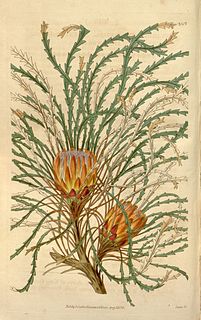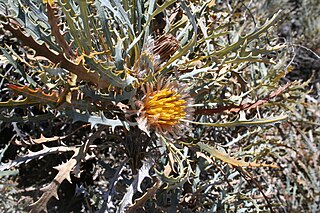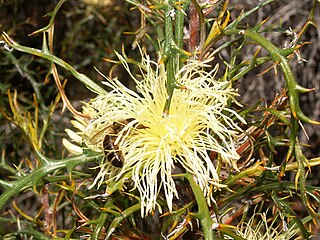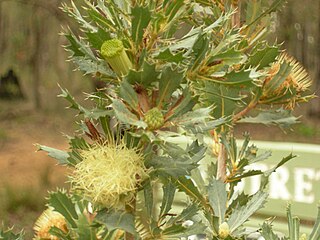
Banksia acanthopoda is a species of shrub in the family Proteaceae. It grows as a small spreading shrub to 2 m high and has prickly leaves and yellow composite flower heads, called inflorescences, composed of 50 to 60 individual yellow flowers. Flowering takes place in the southern hemisphere winter. Endemic to Western Australia, it occurs only in a few populations in the vicinities of Woodanilling, Katanning and Darkan. Because of its rarity, it is classed as "Priority Two" conservation flora by Western Australia's Department of Environment and Conservation.

Banksia armata, commonly known as prickly dryandra, is a species of often sprawling shrub that is endemic to Western Australia. It has deeply serrated leaves with sharply pointed lobes and spikes of about 45 to 70 yellow flowers.

Banksia aurantia, commonly known as the orange dryandra, is a shrub that is endemic to Western Australia. It has underground stems, deeply divided leaves with 18 to 28 lobes on each sides, about eighty pale orange-pink flowers in each inflorescence, and egg-shaped follicles.

Banksia hirta is a species of shrub that is endemic to Western Australia. It has hairy stems, deeply serrated leaves, pale yellow flowers in heads of about one hundred and shining follicles. It is restricted to the Stirling Range National Park.
Banksia ionthocarpa is a species of shrub that is endemic to Western Australia. It has short, hairy, prostrate stems, pinnatifid leaves, pinkish purple to orange flower in heads of between forty and sixty at the base of leaves, and egg-shaped follicles with a distinctive tuft of hairs on the end.

Banksia nobilis, commonly known as the golden dryandra, great dryandra or kerosene bush, is a shrub of the family Proteaceae which is endemic to Western Australia. It occurs on lateritic rises from Eneabba to Katanning in the state's Southwest Botanic Province. With large pinnatifid leaves with triangular lobes, and a golden or reddish pink inflorescence, it is a popular garden plant. It was known as Dryandra nobilis until 2007, when all Dryandra species were transferred to Banksia by Austin Mast and Kevin Thiele. There are two subspecies, B. nobilis subsp. nobilis and B. nobilis subsp. fragrans.
Banksia acuminata is a rare prostrate shrub endemic to south-west Western Australia. It was published in 1848 as Dryandra preissii, but transferred into Banksia as B. acuminata in 2007.
Banksia prionophylla is a shrub endemic to Western Australia. Known only from a single population of around 70 plants in a remote part of Western Australia, it is considered rare but not endangered. It was first discovered in 2001, and published under the genus Dryandra in 2005, before being transferred into Banksia in 2007.

Banksia proteoides, commonly known as king dryandra, is a shrub endemic to Western Australia. It was known as Dryandra proteoides until 2007, when all Dryandra species were transferred to Banksia by Austin Mast and Kevin Thiele.

Banksia serratuloides is a species of small shrub that is endemic to Western Australia. It has linear, pinnatipartite leaves, yellow and pink flowers in heads of about forty and hairy, wrinkled follicles.

Banksia strictifolia is a species of bushy shrub that is endemic to Western Australia. It has serrated, linear leaves with sharply-pointed teeth on both sides, creamy yellow flowers in heads of between forty-five and eighty-five, and egg-shaped to more or less spherical follicles.

Banksia tenuis is a species of shrub that is endemic to the southwest of Western Australia. It has pinnatifid, serrated or smooth-edges leaves, golden brown and cream-coloured flowers in heads of about fifty-five and glabrous, egg-shaped follicles.

Banksia vestita, commonly known as summer dryandra, is a species of shrub that is endemic to the southwest of Western Australia. It has broadly linear, pinnatifid leaves with sharply pointed teeth on both sides, yellow flowers in heads of between thirty and forty, and broadly egg-shaped follicles.

Banksia wonganensis is a large shrub endemic to Western Australia that, until 2007, was previously known as Dryandra wonganensis. It occurs within a small area in the vicinity of the Wongan Hills. It grows on lateritic soils in open woodland or amongst dense shrub. It is rare, but does not appear to be endangered.
Banksia xylothemelia is a sprawling woody shrub of the family Proteaceae endemic to southern Western Australia, one of the many species commonly known as dryandras and until recently called Dryandra xylothemelia. To date it is almost unknown in cultivation.
Banksia trifontinalis is a species of openly-branched shrub that is endemic to the southwest of Western Australia. It has broadly linear, coarsely serrated, sharply pointed leaves, pale yellow flowers in heads of about sixty, and oblong to egg-shaped follicles.

Banksia sessilis var. cordata is a variety of Banksia sessilis, with unusually large leaves and flower heads. It is a rare variety that is restricted to the extreme south-west corner of Western Australia.

Banksia sessilis var. sessilis is the most populous and most widespread variety of Banksia sessilis.

Banksia sessilis var. cygnorum is a variety of Banksia sessilis.
Banksia sessilis var. flabellifolia is a variety of Banksia sessilis.














